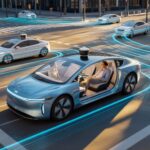
The story of electric vehicles (EVs) is a fascinating journey that spans over a century, reflecting not just advancements in technology but also changes in societal attitudes towards transportation, energy, and the environment.
From early dominance in the automobile market to a period of obscurity, and finally to their current resurgence, electric vehicles have had a rollercoaster history that offers insights into the future of transportation.
The Dawn of Electric Vehicles
The inception of electric vehicles dates back to the early 19th century.
The first crude electric carriage was developed around 1832, well before the internal combustion engine (ICE) became the dominant force in automotive technology.
By the late 19th and early 20th centuries, electric cars enjoyed popularity due to their quiet operation, ease of driving, and absence of noxious fumes—advantages that ICE vehicles could not offer at the time.
Inventors such as Thomas Edison and Ferdinand Porsche contributed to early EV development, with Edison working on battery technologies and Porsche creating the Lohner-Porsche Mixte Hybrid in 1901, the first hybrid electric vehicle.
Despite these innovations, the limited range of electric vehicles, coupled with the lack of widespread electricity infrastructure, remained significant obstacles.
The Rise of the Internal Combustion Engine
The advent of the Ford Model T in 1908 marked a turning point in automotive history.
Its affordability, coupled with the discovery of vast petroleum reserves, led to the dominance of ICE vehicles.
The development of electric starter motors eliminated one of the major inconveniences of gasoline cars—the manual hand crank—making ICE vehicles even more appealing.
By the 1920s, electric vehicles had been largely sidelined, beginning a long period of dormancy.
The Modern Resurgence
Interest in electric vehicles rekindled during the oil crises of the 1970s as fuel prices soared and the environmental impact of fossil fuels became more apparent.
However, it wasn’t until the late 20th and early 21st centuries that technology, environmental concerns, and policy support converged to propel EVs back into the spotlight.
The introduction of the Toyota Prius, the world’s first mass-produced hybrid vehicle, in 1997, marked a significant milestone in the modern era of electric vehicles.
It was followed by pure electric vehicles like the Tesla Roadster in 2008, which shattered the misconception that electric cars could not compete with ICE vehicles in terms of performance and range.
Advancements in Technology and Infrastructure
The evolution of battery technology, particularly lithium-ion batteries, has been a game-changer for electric vehicles, offering higher energy density, longer life spans, and faster charging times.
Advances in motor efficiency, regenerative braking, and lightweight materials have further enhanced the appeal of EVs.
Simultaneously, the development of charging infrastructure, from slow home chargers to rapid charging stations, has addressed one of the most significant barriers to EV adoption—range anxiety.
Governments and private companies worldwide are investing heavily in charging networks, making electric vehicles more viable for everyday use and long-distance travel.
Looking to the Future
Today, nearly every major automaker has committed to electrifying their fleets, with some pledging to become entirely electric in the coming decades.
The conversation around electric vehicles has shifted from feasibility to inevitability.
The focus is now on improving battery technology, expanding charging infrastructure, and integrating EVs into a cleaner, more sustainable energy grid.
As we look to the future, electric vehicles stand at the forefront of a transportation revolution, promising a cleaner, quieter, and more efficient way to move around our planet.
The history of EVs is not just a testament to human ingenuity and persistence but also a reminder of our ability to adapt and innovate for a better future.


